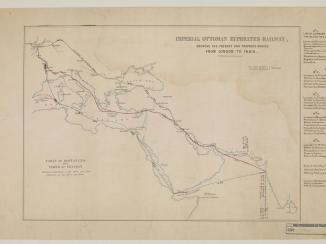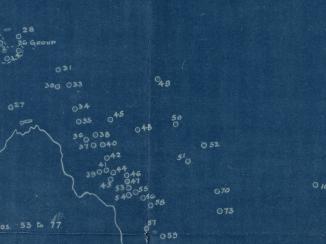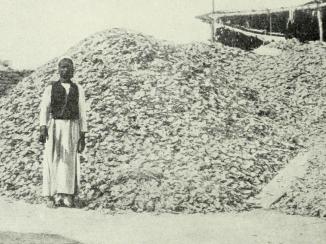‘File 5/168 IV Manumission of slaves on Arab Coast: individual cases’
IOR/R/15/1/208
1,006 items in this record
Search within this record
The record is made up of 1 volume (469 folios). It was created in 19 Feb 1925-18 Mar 1931. It was written in English and Arabic. The original is part of the British Library: India Office The department of the British Government to which the Government of India reported between 1858 and 1947. The successor to the Court of Directors. Records and Private Papers Documents collected in a private capacity. .
About this record
- Content
The volume contains correspondence related to thirty-five slave-related cases or subjects, the majority of which deal with straightforward procedures of manumission. In these cases, the Residency An office of the East India Company and, later, of the British Raj, established in the provinces and regions considered part of, or under the influence of, British India. Agent at Sharjah (‘Īsá bin ‘Abd al-Latif) wrote to the Political Resident A senior ranking political representative (equivalent to a Consul General) from the diplomatic corps of the Government of India or one of its subordinate provincial governments, in charge of a Political Residency. at Bushire, enclosing a statement made by the slave(s), and advising whether he believed the slave (or slaves) should be manumitted. The Political Resident A senior ranking political representative (equivalent to a Consul General) from the diplomatic corps of the Government of India or one of its subordinate provincial governments, in charge of a Political Residency. replied, informing ‘Īsá that he may do so.
Three subjects in the file are extraordinary in nature, as follows:
- Subject 9 is a manumission case involving a women who took refuge with the Resident Agent in Sharjah in 1926, with her four children. The woman claimed that she was originally a free person who had been enslaved with her four children. Included in the subject correspondence (folio 108) is a handwritten manumission certificate (in Arabic) given to the woman by her mother, stating that the mother and her children were free people. The certificate is a unique example in the Bushire Slavery subject files of a handwritten manumission certificate, given to a slave by their owner.
- Subject 10 contains letters written in 1925 to the Political Resident A senior ranking political representative (equivalent to a Consul General) from the diplomatic corps of the Government of India or one of its subordinate provincial governments, in charge of a Political Residency. (then Lieutenant-Colonel Charles Crosthwaite) from the shaikhs of Sharjah, Abu Dhabi, Dubai, Ajman, Ra's al-Khaymah and Umm al-Qaywayn (folios 120-23, 129). The letters were a coordinated response between the Trucial Coast A name used by Britain from the nineteenth century to 1971 to refer to the present-day United Arab Emirates. shaikhs, communicating their unhappiness about indebted slaves absconding from their boat masters, and the Political Resident’s perceived inaction on the matter. Each letter was sent to the Political Resident A senior ranking political representative (equivalent to a Consul General) from the diplomatic corps of the Government of India or one of its subordinate provincial governments, in charge of a Political Residency. at the same time. The Political Resident A senior ranking political representative (equivalent to a Consul General) from the diplomatic corps of the Government of India or one of its subordinate provincial governments, in charge of a Political Residency. responded by saying that he took the matter seriously, and requested the shaikhs to send details of absconding divers to him. The shaikhs of Dubai and Sharjah responded by sending details to the Political Resident A senior ranking political representative (equivalent to a Consul General) from the diplomatic corps of the Government of India or one of its subordinate provincial governments, in charge of a Political Residency. of a number of divers’ balance books, that showed their level of debt and earnings
- Subject 30 documents an incident on the evening of 31 January 1931, when one-hundred armed men surrounded the Residency An office of the East India Company and, later, of the British Raj, established in the provinces and regions considered part of, or under the influence of, British India. Agent’s house in Sharjah, demanding the return of a number of slaves. The incident was reported to the Political Resident A senior ranking political representative (equivalent to a Consul General) from the diplomatic corps of the Government of India or one of its subordinate provincial governments, in charge of a Political Residency. , and HMS Hastings dispatched to monitor the situation. Testimonies identified the ringleader of the armed gang as an associate of the shaikh of Sharjah, Saqr bin Sultan. British officials gave the shaikh an ultimatum to deport the man to Aden. Refusal to do so would result in the shaikh having to hand over 2,000 rupees Indian silver coin also widely used in the Persian Gulf. and 100 rifles to British officials. The Political Resident A senior ranking political representative (equivalent to a Consul General) from the diplomatic corps of the Government of India or one of its subordinate provincial governments, in charge of a Political Residency. and the Senior Naval Officer in the Gulf agreed that refusal to do this could result in the town being bombarded (folio 373). The shaikh refused to deport the ringleader, and on the day of the ultimatum, he delivered up 1,200 rupees Indian silver coin also widely used in the Persian Gulf. and 60 rifles. This offer was refused by the Commanding Officer of HMS Hastings (389). Within hours of the ultimatum expiring the Shaikh delivered 2000 rupees Indian silver coin also widely used in the Persian Gulf. and 100 rifles, but was ordered to replace six rifles that were found to not be in working order (folio 395).
- Extent and format
- 1 volume (469 folios)
- Arrangement
Correspondence within the volume is grouped by manumission cases, or subjects, ordered approximately in chronological order from earliest at the front of the volume, to latest at the rear. At the beginning of the volume (ff.2-3) is a handwritten index, which lists the manumission subjects (with slaves' names) from 1 to 34. Some manumission subjects involve two or more slaves. Each subject has its own handwritten cover sheet. The index does not refer to specific page numbers for each subject.
- Physical characteristics
Foliation: The volume has been foliated from the cover sheet to the last page of writing, using pencil numbers in the top-right corner of each recto The front of a sheet of paper or leaf, often abbreviated to 'r'. . Each manumission subject has its own internal numbering system, also top-right of each recto The front of a sheet of paper or leaf, often abbreviated to 'r'. , expressed as page x of subject y.
Some pages in the volume were cropped when bound at a later date, meaning that text close to edges of papers has been lost, but not to such an extent as to be a detriment to readability.
- Written in
- English and Arabic in Latin and Arabic script
- Type
- Archival file
Archive information for this record
- Original held at
- British Library: India Office The department of the British Government to which the Government of India reported between 1858 and 1947. The successor to the Court of Directors. Records and Private Papers Documents collected in a private capacity.
- Access conditions
Unrestricted
- Archive reference
- IOR/R/15/1/208
- Former external reference(s)
- A Series: 5/168 IV
- Date(s)
- 19 Feb 1925-18 Mar 1931 (CE, Gregorian)
- Context of creation
The native Residency An office of the East India Company and, later, of the British Raj, established in the provinces and regions considered part of, or under the influence of, British India. Agent at Sharjah, did not have the power to grant manumission to slaves seeking refuge at his office. All manumission requests had to be forwarded by him to the Political Resident A senior ranking political representative (equivalent to a Consul General) from the diplomatic corps of the Government of India or one of its subordinate provincial governments, in charge of a Political Residency. in Bushire. Manumission cases were judged according to the guidelines for manumission first issued by Political Resident A senior ranking political representative (equivalent to a Consul General) from the diplomatic corps of the Government of India or one of its subordinate provincial governments, in charge of a Political Residency. Percy Cox in 1913 [IOR/R/15/1/234].
During the period in question the Gulf's pearling industry was in steep decline; a result of the introduction of cheaper cultured pearls from Japan, and a drop in the demand for pearls in the wake of the First World War. The decline of the industry, upon which the livelihood of the Trucial coasted relied, meant that many pearl divers earned an insufficient amount to support themselves, and steadily built up large debts. One means of escaping debt was to claim to be slave, and seek manumission from a British Agency An office of the East India Company and, later, of the British Raj, headed by an agent. .
Access & Reference
History of this record
Related search terms
Use and share this record
- Share this record
- Cite this record in your research
‘File 5/168 IV Manumission of slaves on Arab Coast: individual cases’, British Library: India Office Records and Private Papers, IOR/R/15/1/208, in Qatar Digital Library <https://www.qdl.qa/node/9440> [accessed 10 May 2024]
- Link to this record
https://www.qdl.qa/en/archive/81055/vdc_100000000193.0x0000b5
- IIIF details
This record has a IIIF manifest available as follows. If you have a compatible viewer you can drag the icon to load it.https://www.qdl.qa/en/iiif/81055/vdc_100000000193.0x0000b5/manifestOpen in Universal viewerOpen in Mirador viewerMore options for embedding images
Copyright: How to use this content
- Reference
- IOR/R/15/1/208
- Title
- ‘File 5/168 IV Manumission of slaves on Arab Coast: individual cases’
- Pages
- 41r:41v, 48r:48v, 65r:65v, 83r:83v
- Author
- Āl Maktūm, Shaikh Saʻīd bin Maktūm bin Hasher
- Usage terms
- Public Domain
- Reference
- IOR/R/15/1/208
- Title
- ‘File 5/168 IV Manumission of slaves on Arab Coast: individual cases’
- Pages
- 108r:108v
- Author
- Mitba
- Usage terms
- The copyright status is unknown. Please contact copyright@bl.uk with any information you have regarding this item.
- Reference
- IOR/R/15/1/208
- Title
- ‘File 5/168 IV Manumission of slaves on Arab Coast: individual cases’
- Pages
- 120r:120v
- Author
- Al Qasimi, Shaikh Sultan bin Salim
- Usage terms
- Public Domain
- Reference
- IOR/R/15/1/208
- Title
- ‘File 5/168 IV Manumission of slaves on Arab Coast: individual cases’
- Pages
- 120ar:120av
- Author
- Al Nuaimi, Shaikh Humaid IV bin 'Abd' al'Aziz
- Usage terms
- Public Domain
- Reference
- IOR/R/15/1/208
- Title
- ‘File 5/168 IV Manumission of slaves on Arab Coast: individual cases’
- Pages
- 121r:121v, 139ar:139av
- Author
- Al Qasimi, Shaikh Sultan II bin Saqr
- Usage terms
- Public Domain
- Reference
- IOR/R/15/1/208
- Title
- ‘File 5/168 IV Manumission of slaves on Arab Coast: individual cases’
- Pages
- 122r:122v
- Author
- Al Nahyan, Shaikh Sultan bin Zayed
- Usage terms
- Public Domain
- Reference
- IOR/R/15/1/208
- Title
- ‘File 5/168 IV Manumission of slaves on Arab Coast: individual cases’
- Pages
- 123r:123v, 131r:131v, 191ar:191av, 192ar:192av, 300r:300v, 328r:328v
- Author
- Āl Maktūm, Shaikh Saʻīd bin Maktūm bin Hasher
- Usage terms
- Public Domain
- Reference
- IOR/R/15/1/208
- Title
- ‘File 5/168 IV Manumission of slaves on Arab Coast: individual cases’
- Pages
- 129r
- Author
- Al Mu'alla, Shaikh Hamad bin Ibrahim
- Usage terms
- Public Domain
- Reference
- IOR/R/15/1/208
- Title
- ‘File 5/168 IV Manumission of slaves on Arab Coast: individual cases’
- Pages
- 132r:132v
- Author
- Bushir bin Umran bin Abdullah
- Usage terms
- The copyright status is unknown. Please contact copyright@bl.uk with any information you have regarding this item.
- Reference
- IOR/R/15/1/208
- Title
- ‘File 5/168 IV Manumission of slaves on Arab Coast: individual cases’
- Pages
- 140r:140v
- Author
- Sanqur the Baluchi
- Usage terms
- The copyright status is unknown. Please contact copyright@bl.uk with any information you have regarding this item.
- Reference
- IOR/R/15/1/208
- Title
- ‘File 5/168 IV Manumission of slaves on Arab Coast: individual cases’
- Pages
- 141r:141v
- Author
- Musah bin Ahmad
- Usage terms
- The copyright status is unknown. Please contact copyright@bl.uk with any information you have regarding this item.
- Reference
- IOR/R/15/1/208
- Title
- ‘File 5/168 IV Manumission of slaves on Arab Coast: individual cases’
- Pages
- 190ar:190av
- Author
- Al Nahyan, Shaikh Saqr bin Zayed
- Usage terms
- Public Domain
- Reference
- IOR/R/15/1/208
- Title
- ‘File 5/168 IV Manumission of slaves on Arab Coast: individual cases’
- Pages
- 299ar:299av
- Author
- Al Abu Falasa, Shaikh Hashur bin Maktoum
- Usage terms
- Public Domain
- Reference
- IOR/R/15/1/208
- Title
- ‘File 5/168 IV Manumission of slaves on Arab Coast: individual cases’
- Pages
- 345r:345v
- Author
- Mehta, M D
- Copyright
- ©Inchcape plc
- Usage terms
- Creative Commons Non-Commercial Licence
- Reference
- IOR/R/15/1/208
- Title
- ‘File 5/168 IV Manumission of slaves on Arab Coast: individual cases’
- Pages
- 346r:346v
- Author
- Al Abu Falasa, Shaikh Hashur bin Maktoum
- Usage terms
- Public Domain
- Reference
- IOR/R/15/1/208
- Title
- ‘File 5/168 IV Manumission of slaves on Arab Coast: individual cases’
- Pages
- 344r:344v
- Author
- Yusuf bin Abdullah
- Usage terms
- The copyright status is unknown. Please contact copyright@bl.uk with any information you have regarding this item.
- Reference
- IOR/R/15/1/208
- Title
- ‘File 5/168 IV Manumission of slaves on Arab Coast: individual cases’
- Pages
- 343r:343v
- Author
- Haji Ahmed ben Abdollah ben Lutah
- Usage terms
- The copyright status is unknown. Please contact copyright@bl.uk with any information you have regarding this item.
- Reference
- IOR/R/15/1/208
- Title
- ‘File 5/168 IV Manumission of slaves on Arab Coast: individual cases’
- Pages
- 426r:426v
- Author
- Haidar-Abadai, Mukhtar bin Abdul Latif
- Usage terms
- The copyright status is unknown. Please contact copyright@bl.uk with any information you have regarding this item.
- Reference
- IOR/R/15/1/208
- Title
- ‘File 5/168 IV Manumission of slaves on Arab Coast: individual cases’
- Pages
- 427r:427v
- Author
- Al Najjar, Abdullah bin Hasan
- Usage terms
- The copyright status is unknown. Please contact copyright@bl.uk with any information you have regarding this item.
- Reference
- IOR/R/15/1/208
- Title
- ‘File 5/168 IV Manumission of slaves on Arab Coast: individual cases’
- Pages
- front, front-i, i-r:ii-v, 1r:1v, 1ar:1av, 2r:3v, 3ar:3dv, 4r:40v, 42r:47v, 49r:64v, 66r:82v, 84r:107v, 109r:118v, 118ar:118av, 119r:119v, 124r:128v, 129v:130v, 130ar:130av, 133r:139v, 142r:208v, 208ar:208av, 209r:210v, 210ar:210av, 211r:215v, 215ar:215av, 216r:226v, 226ar:226av, 227r:244v, 244ar:244av, 245r:245v, 246v:258v, 258ar:258av, 259r:264v, 264ar:264av, 265r:270v, 270ar:270av, 271r:285v, 285ar:285av, 286r:292v, 292ar:292av, 293r:299v, 301v:327v, 329r:339v, 340ar:340av, 340r:341v, 342ar:342av, 342r:342v, 347r:425v, 428r:432v, 432ar:432av, 433r:471v, iii-r:v-v, back-i, back
- Author
- East India Company, the Board of Control, the India Office, or other British Government Department
- Usage terms
- Open Government Licence



















































































































































































































































































































































































































































































































































































































































































































































































































































































































































































































































